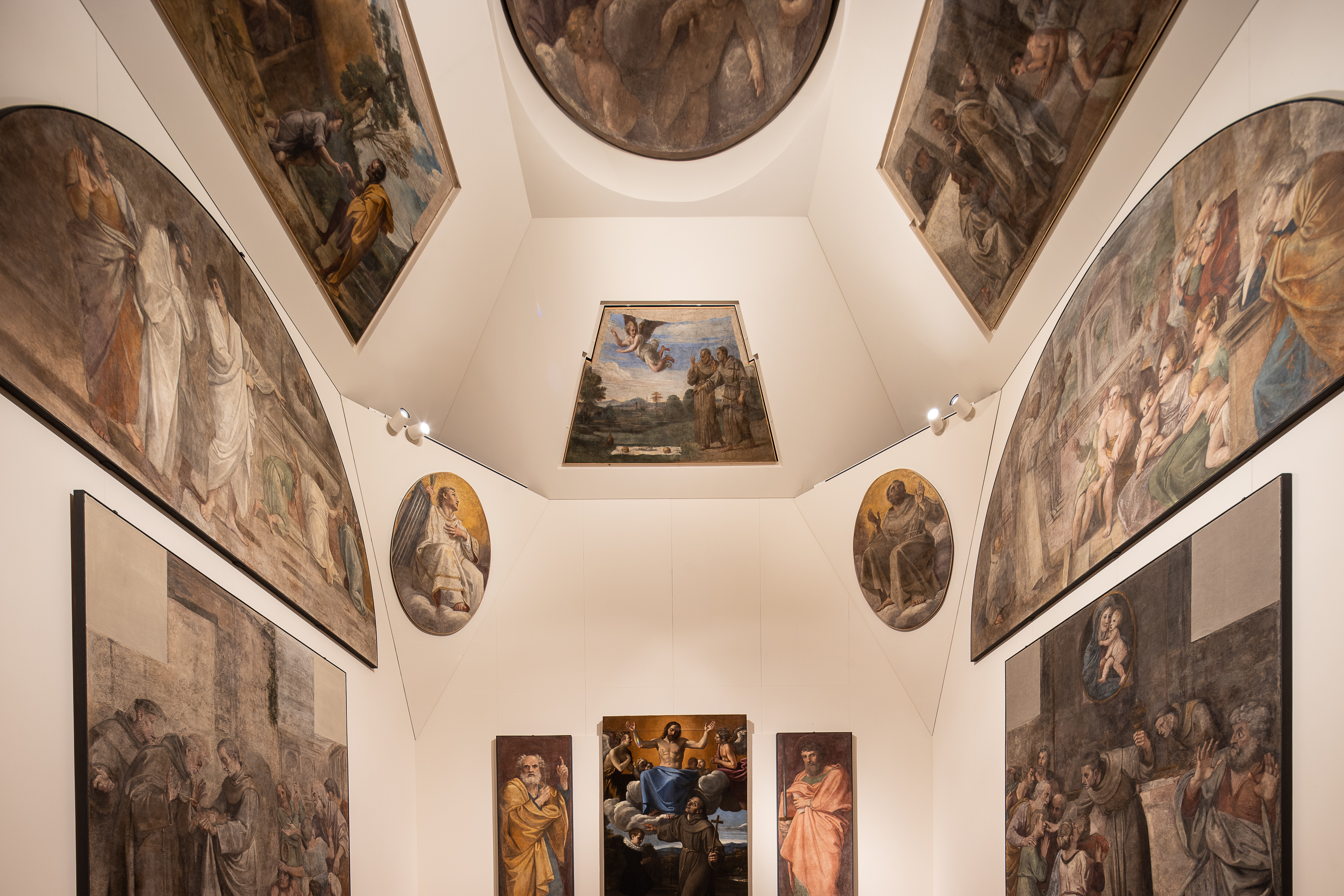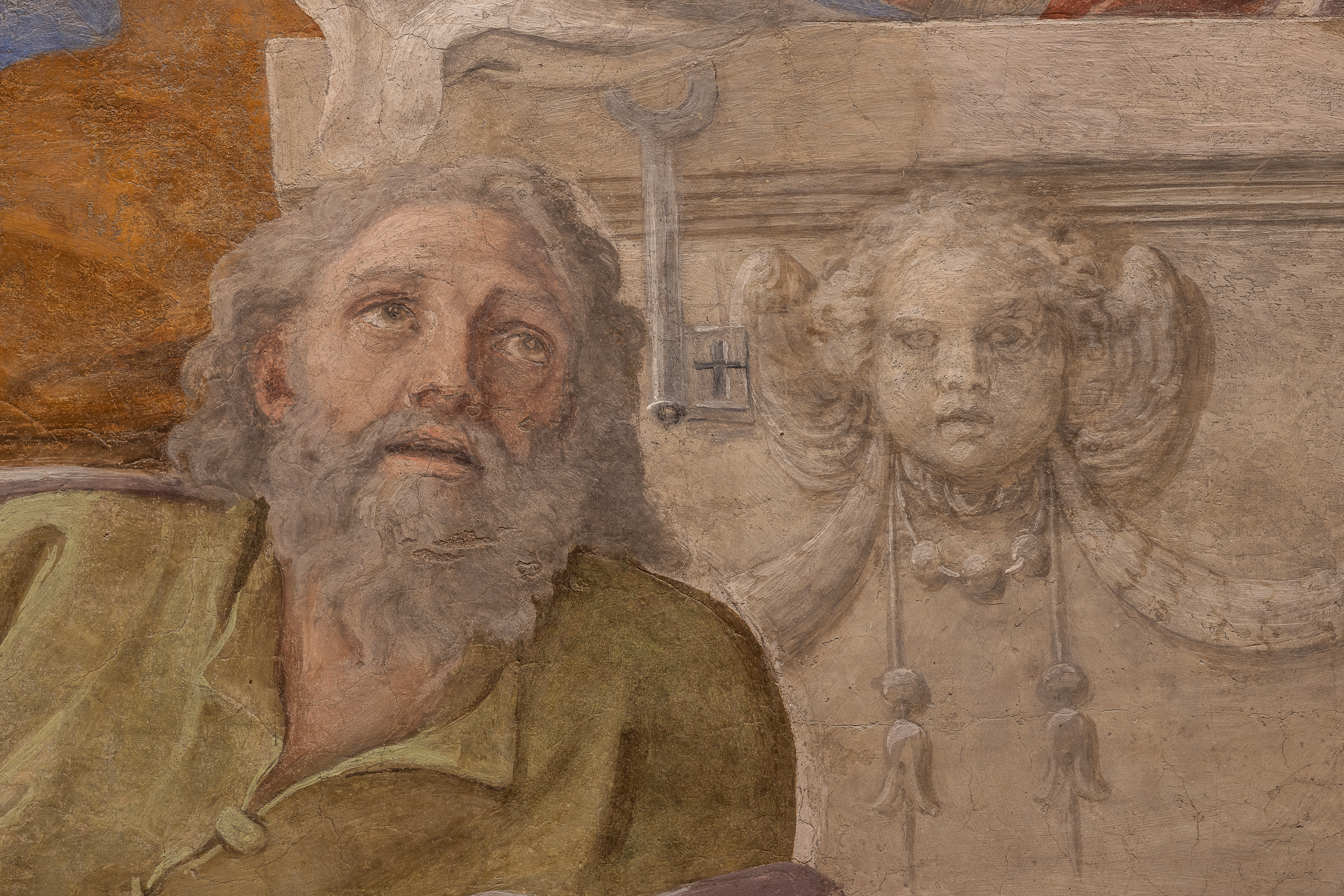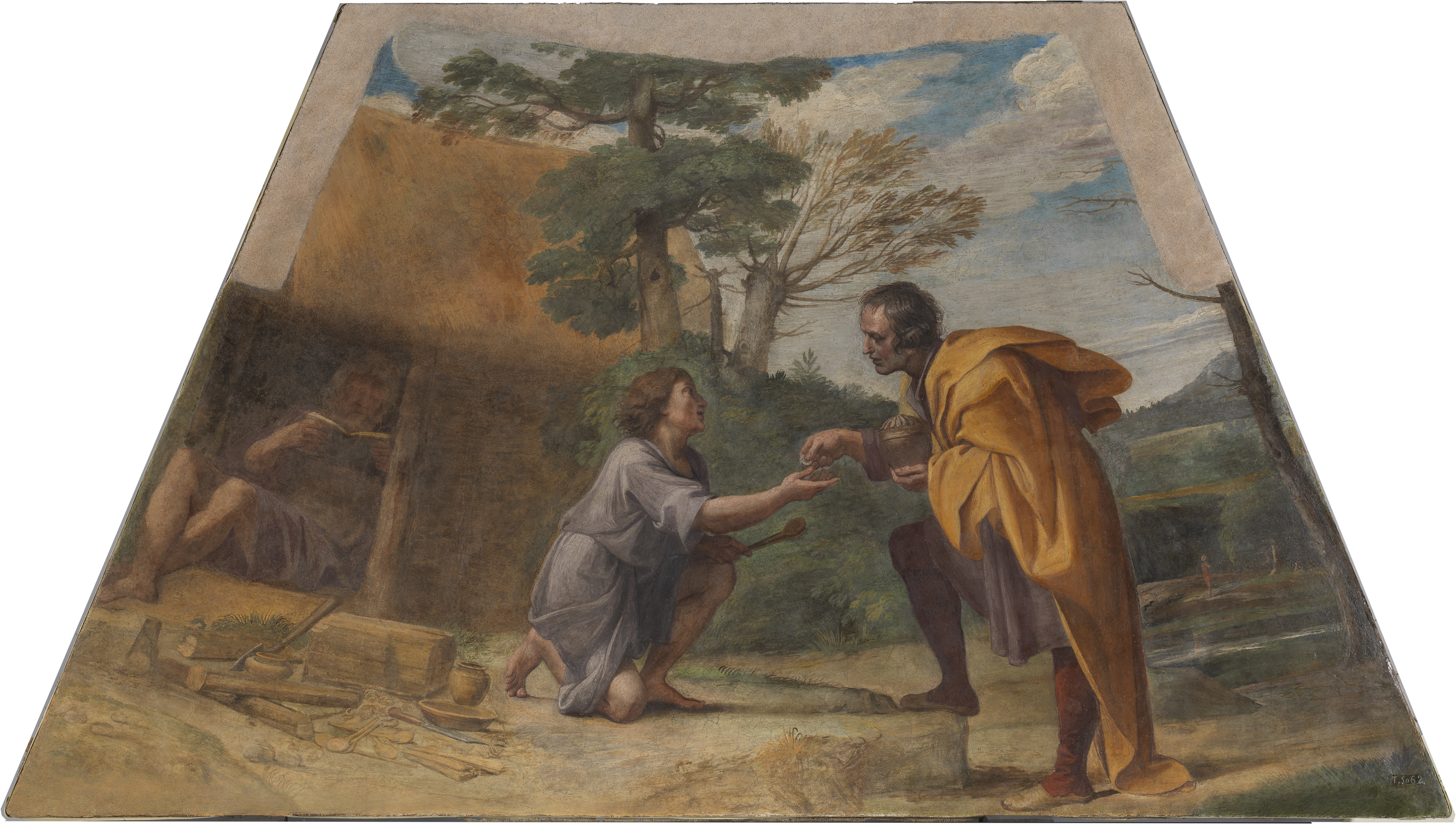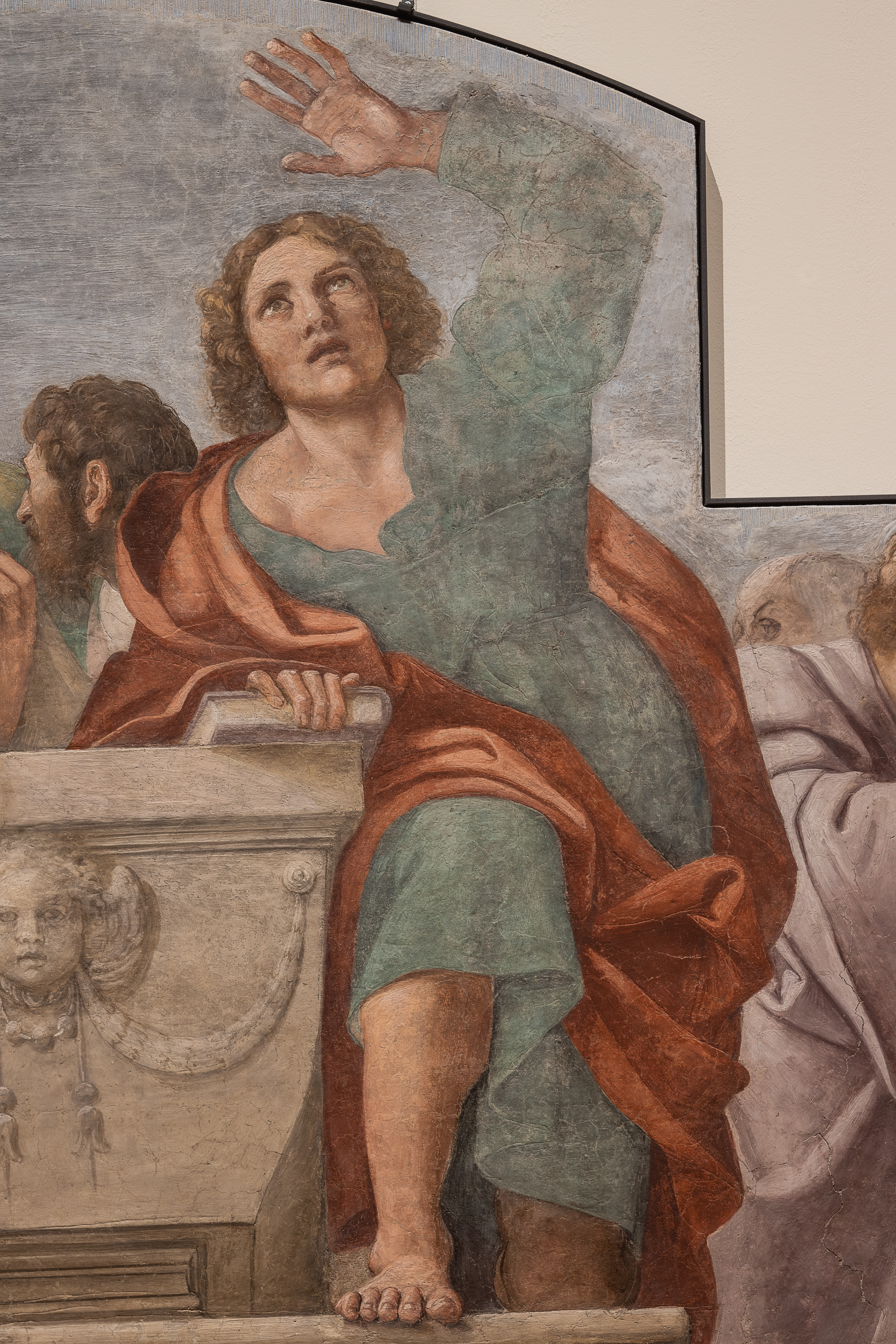The Apostles around the empty tomb, Fresco transferred to canvas, Museo Nacional de Arte de Cataluña. Depósito de la Real Academia de Bellas Artes de Sant Jordi
That is why today the reconstruction, in the Sala Marmi of Palazzo Barberiniof the Herrera Chapel, dismantled in 1830 and now rebuilt with its frescoes according to the original sequence of the cycle, after two hundred years of oblivion, takes on a particular value by returning to the public a jewel of seventeenth-century Bolognese Roman painting in the same Rome for which it was been accomplished.

Reconstruction of the Herrera Chapel in the Marble Hall of Palazzo Barberini | Photo: © Alberto Novelli
But let’s proceed with order in retracing the events of this fascinating sentimental story.
In the early seventeenth century Annibale Carracci received in Rome from the well-known Spanish banker Juan Enriquez de Herrera the commission to create the entire cycle dedicated to the Franciscan saint Diego of Alcalá. The decoration was supposed to embellish the family chapel in the Church of San Giacomo degli Spagnoli in Piazza Navona. Thus, like a passionate “construction manager”, Annibale Carracci entrusted some of the most important frescoes to his hand until, in 1605, the serious illness that struck him – and from which he would never recover – forced the artist to entrust execution to Francesco Albani and a small group of collaborators, including Domenichino, Giovanni Lanfranco and Sisto Badalocchio.
The decoration of the chapel was completed in a very short time, as shown by the days of work highlighted in the individual frescoes during the restorations. Unfortunately, in the 19th century the Herrera chapel (inside the still existing Church of San Giacomo degli Spagnoli in Piazza Navona) was dismantled and in 1830 the frescoes were detached, transferred to canvas and taken to the Church of Santa Maria in Monserrato degli Spagnoli. Before long they would fly to Spain to be divided between the Prado Museum in Madrid and the Sant Jordi Royal Catalan Academy of Fine Arts in Barcelona.
Currently seven fragments are kept in Madrid, in the Prado Museum, and nine in Barcelona at the Museu Nacional d’Art de Catalunya (MNAC), while the location of the remaining three fragments of decoration remains unknown.

Reconstruction of the Herrera Chapel, Sala Marmi of Palazzo Barberini | Photo: © Alberto Novelli
Today that extraordinary casket that was the Herrera Chapel, dismantled and dispersed, reappears after two hundred years in the same city, Rome, for which it was built, rebuilt thanks to the joint work of three major international institutions, with its frescoes repositioned in the same arrangement designed by Carracci and his illustrious collaborators. To understand how this immense “multi-handed” casket looked like, the result of the collaboration between artists who worked in unison to create the chapel of one of the most illustrious bankers in Rome at the time, just take a trip to Palazzo Barberini where from today, November 17, until February 5the exhibition Annibale Carracci. The frescoes of the Herrera chapelguides the public directly “into” the chapel, bringing it to life again in a hall of the building.
The exhibition curated by Andrés Úbeda de los Cobos, deputy director of the Prado Museum, and organized with the Museo Nacional del Prado and the Museu Nacional d’Art de Catalunya, as explained by Flaminia Gennari Santori, director of the National Galleries of Ancient Art, “ it will be a unique opportunity to understand what the Herrera chapel in San Giacomo degli Spaniards was, admired and imitated in the 17th and 18th centuries and destroyed in 1830, as well as naturally constituting a fundamental opportunity for research and studies on Annibale Carracci and his shop”.
The itinerary, which had two previous stages, at the Prado Museum in Madrid and at the Museu Nacional d’Art de Catalunya in Barcelona, brings together the cycle of frescoes designed by Annibale Carracci for the decoration of the family chapel of the Spanish banker Juan Enriquez de Herrera in the Church of San Giacomo degli Spagnoli in Piazza Navona.
“But only in the Rome exhibition, where the space of the chapel has been literally rebuilt and the frescoes have been placed exactly in the position they originally had, is it possible to better perceive what this chapel was like, and to understand the motif of the oval or trapezoidal paintings” explains curator Andrés Úbeda de los Cobos, deputy director of the Prado Museum.

San Diego de Alcalá receiving alms, fresco transferred to canvas, 222 x 126 cm, Museo Nacional del Prado
Thanks to the probable intervention of the aids, Carracci also painted the altarpiece, San Diego de Alcalà presents the son of Juan de Herrera to Jesus Christtoday in a chapel of the Church of Santa Maria in Monserrato degli Spagnoli and exceptionally reunited, on the occasion of the exhibition, with the frescoes that surrounded it in the Herrera chapel.
In the spaces of the Sala Marmi, the Sala Ovale and the Sala Paesaggi of Palazzo Barberini the sixteen frescoes stand out alongside a selection of drawings, the beautiful View of Rome by Gaspar van Wittel, with Piazza Navona and the façade of the church of San Giacomo as it appeared at the time.
A video produced by the Prado Museum illustrates the events linked to the genesis of the chapel, the authors and iconography, the Church of San Giacomo degli Spagnoli, the dispersion of the paintings and finally their restoration.
On the occasion of the exhibition, the catalog was published, a co-edition between the Museo Nacional del Prado, the Museu Nacional d’Art de Catalunya, the National Galleries of Ancient Art, the three institutions organizing the exhibition, published by the Museo Nacional del Prado Difusión for the version in Spanish and Catalan and by Skira Editore for the Italian version.

Reconstruction of the Herrera Chapel, Sala Marmi of Palazzo Barberini | Photo: © Alberto Novelli
![]() Read also:
Read also:
• The Herrera Chapel by Annibale Carracci lives again in the Prado
• Annibale Carracci. The frescoes of the Herrera Chapel

